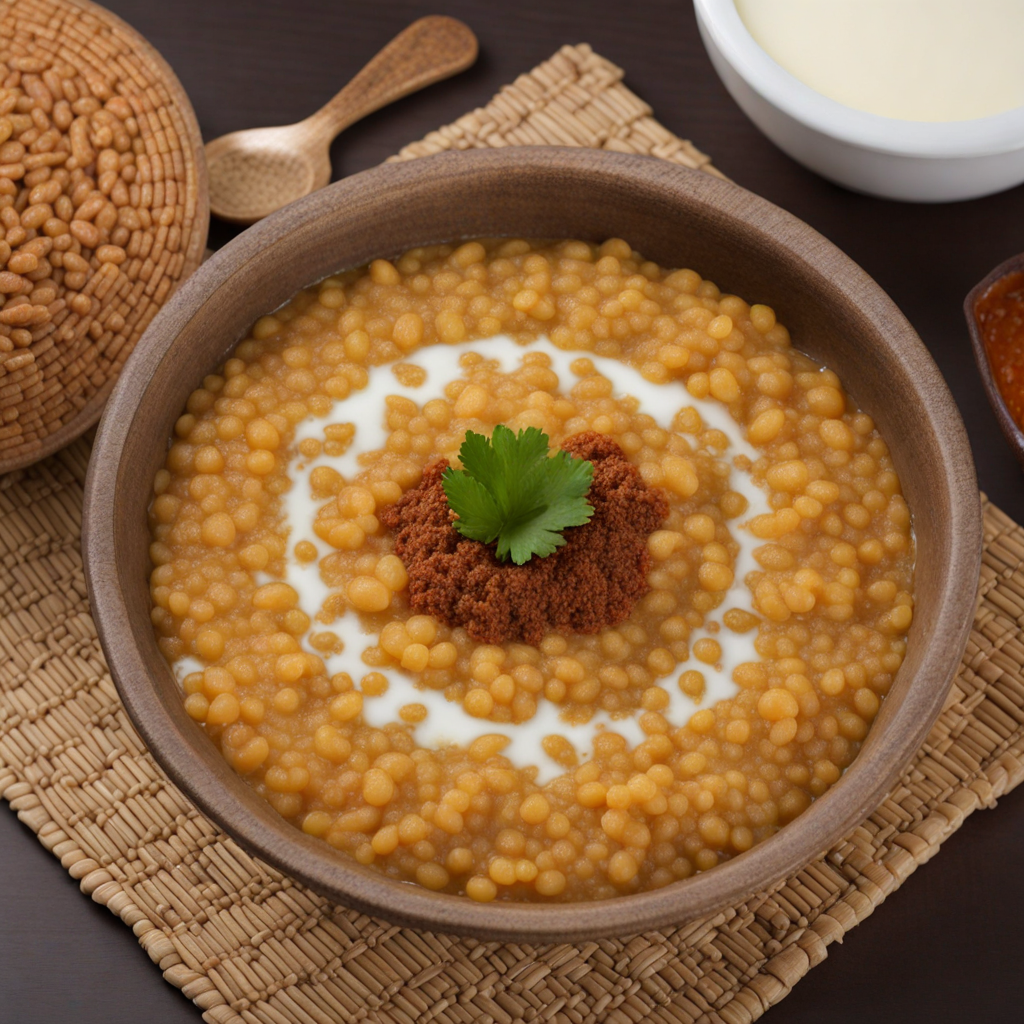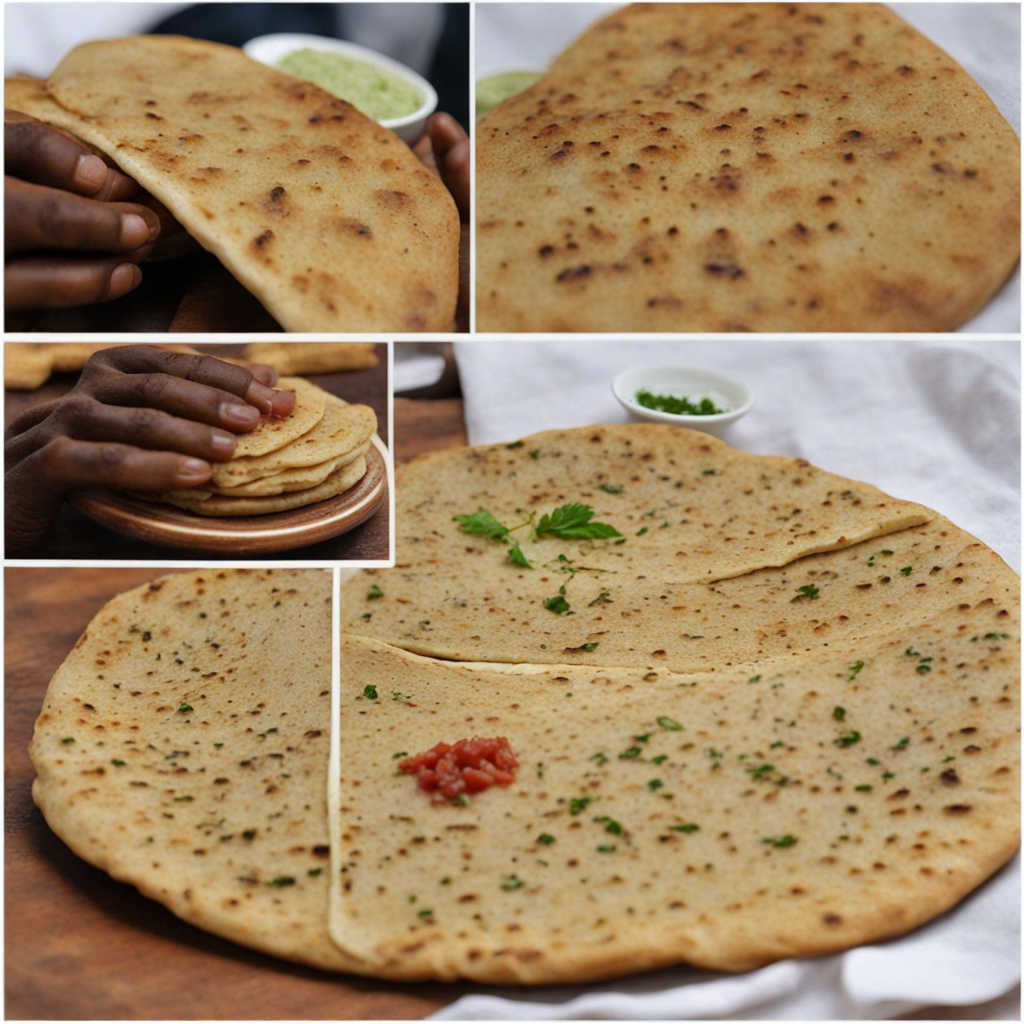Genfo
Genfo is a traditional Ethiopian dish that showcases the country's rich culinary heritage, characterized by its unique texture and flavor. At its core, Genfo is a type of porridge made primarily from barley or wheat flour. The grain is cooked with water until it reaches a thick, dough-like consistency, resulting in a hearty base that is both comforting and satisfying. The texture is smooth yet slightly sticky, making it perfect for scooping with the fingers or served alongside a traditional Ethiopian injera (sourdough flatbread). What sets Genfo apart is the accompanying sauce, typically made from spiced clarified butter known as 'kibe' and a blend of spices, including berbere—a key ingredient in Ethiopian cuisine that provides a warm, smoky heat. This sauce is drizzled over the Genfo, infusing it with rich flavors and a delightful aroma. Some variations also include a sprinkle of powdered ginger or other spices, enhancing the dish's complexity and depth. The combination of the creamy porridge and the fragrant, spicy butter creates a harmonious balance that tantalizes the taste buds. Genfo is often enjoyed as a breakfast dish or a comforting meal during colder months, symbolizing warmth and nourishment. It is typically served in a communal style, encouraging sharing and connection among family and friends. Whether you're dipping pieces of injera into the porridge or enjoying it straight from the bowl, Genfo offers a delightful culinary experience that invites you to explore the vibrant flavors of Ethiopian cuisine.
How It Became This Dish
The History and Cultural Significance of ገንፎ (Genfo) in Ethiopian Cuisine #### Origins of Genfo Genfo (ገንፎ) is a traditional Ethiopian dish that has been an integral part of the country’s culinary landscape for centuries. The origins of Genfo can be traced back to the diverse agricultural practices and cultural exchanges that have characterized Ethiopia's history. The dish is primarily made from barley or wheat flour, which is mixed with water to create a thick porridge-like consistency. The simple ingredients reflect the agrarian lifestyle of Ethiopian communities, particularly in the highland regions, where barley and wheat have long been staples. Barley, one of the oldest cultivated grains, has been utilized in Ethiopian kitchens since ancient times, with evidence of its cultivation dating back over 3,000 years. Wheat was introduced later, but both grains have become vital in the Ethiopian diet, serving as the foundation for various dishes, including Genfo. The preparation of Genfo is often associated with communal eating, reflecting the deep-seated cultural practices of hospitality and sharing in Ethiopian society. #### Cultural Significance Genfo holds a significant place in Ethiopian culture, particularly as a breakfast dish. Traditionally served hot, Genfo is often accompanied by a rich sauce made from spiced clarified butter (known as 'kibe') and berbere, a quintessential Ethiopian spice blend made from chili peppers, garlic, ginger, and other spices. The combination of the warm, soft porridge with the flavorful sauce creates a hearty and nourishing meal that is beloved across the country. In Ethiopian culture, food is not merely sustenance; it is a means of fostering community and connection. Genfo is often prepared during special occasions, such as holidays, family gatherings, and religious celebrations. It is a dish that transcends social classes, enjoyed by all, from rural households to urban dwellers. During the fasting period in the Ethiopian Orthodox calendar, when many abstain from animal products, Genfo remains a popular choice as it provides the necessary energy and nutrition. The communal aspect of eating Genfo is also noteworthy. Traditionally, it is served in a large communal bowl, and diners use their hands to scoop up the dish. This act of eating together fosters a sense of unity and belonging among family and friends. Such practices are deeply rooted in Ethiopian culture, where sharing food symbolizes goodwill and kinship. #### Development Over Time As Ethiopia underwent political and social changes over the centuries, so too did its culinary practices. The introduction of new ingredients and cooking techniques, influenced by trade and cultural exchanges with neighboring regions, has shaped the evolution of Genfo. For instance, the growing popularity of teff, another ancient grain native to Ethiopia, has led to variations of Genfo made with teff flour, known as "Teff Genfo." This adaptation highlights the ongoing evolution of Ethiopian cuisine, where traditional dishes are reimagined with locally sourced ingredients. In recent decades, as globalization has influenced culinary practices worldwide, Genfo has gained recognition beyond Ethiopia's borders. Ethiopian restaurants around the globe serve Genfo as part of their offerings, introducing this hearty dish to new audiences. As a result, Genfo has not only maintained its traditional roots but has also adapted to meet contemporary tastes, with some variations incorporating modern cooking methods or ingredients. The rise of the internet and social media has also played a significant role in elevating Genfo's profile. Food bloggers and influencers have shared recipes and cooking techniques, allowing a wider audience to discover this traditional dish. As more people become interested in global cuisines, Genfo has found its way into the homes of food enthusiasts eager to explore Ethiopian culinary heritage. #### Contemporary Variations and Innovations In modern Ethiopia, Genfo continues to be a beloved dish, but its preparation and presentation have evolved. Chefs and home cooks alike are experimenting with flavors and textures, creating innovative versions of Genfo that cater to diverse palates. Some variations incorporate additional ingredients such as vegetables, cheeses, or fermented flavors, while others focus on health-conscious adaptations, using whole grains or gluten-free alternatives. Genfo is also increasingly featured in Ethiopia's burgeoning food tourism sector. As travelers flock to Ethiopia to experience its rich history, culture, and cuisine, Genfo has become a standout dish that symbolizes the country’s culinary identity. Cooking classes and culinary tours often include Genfo preparation, providing visitors with an opportunity to engage with Ethiopian culture through its food. In addition to its culinary evolution, Genfo holds a place in Ethiopian literature and folklore, symbolizing nourishment and care. Stories and songs often reference the act of preparing and sharing Genfo, highlighting its importance in the social fabric of Ethiopian life. This cultural reverence underscores the dish’s role not just as food but as a vessel of tradition and community. #### Conclusion Genfo is more than just a dish; it is a representation of Ethiopian culture, history, and communal values. From its ancient origins rooted in Ethiopian agriculture to its contemporary adaptations and global recognition, Genfo continues to be a source of pride for Ethiopians around the world. As it evolves, it remains a testament to the resilience and richness of Ethiopian culinary traditions, preserving the essential spirit of sharing and togetherness that defines the Ethiopian way of life. Whether enjoyed in a family home in Addis Ababa or a restaurant in New York City, Genfo serves as a delicious reminder of the connections that food fosters across cultures and generations.
You may like
Discover local flavors from Ethiopia







